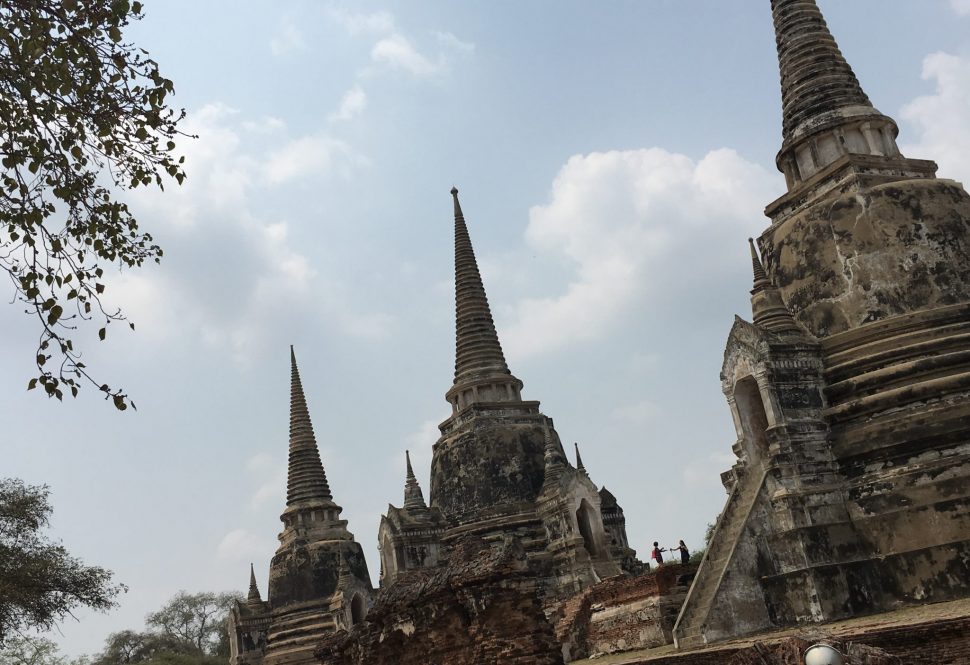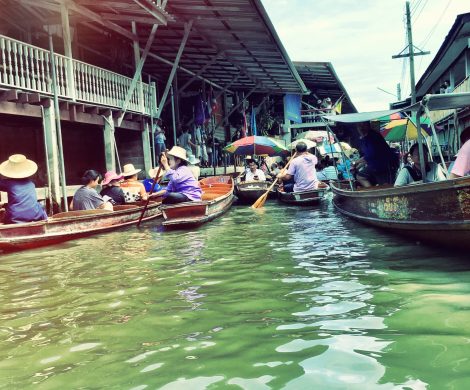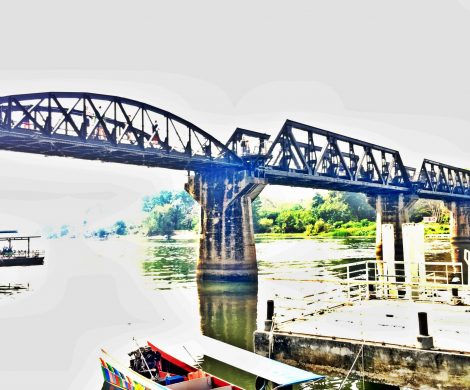
Through Thatha’s stories I imagined the Kingdom of Ayodhya on the banks of the Sarayu river, the birthplace of the God-King Ram to be a magical place with spiralling mansions studded with gemstones, sprawling gardens and glorious monarchs riding in sparkly chariots.
I have never visited Ayodhya, even though I grew up about 200km away in Kanpur. I didn’t even realize for many years that it was a real city, preferring the one in my imagination. I was 14 when the Babri Masjid massacre took place and found out that Ayodhya was real. A small, rustic city with a population of 55,000 people, suddenly brought front and centre into national prominence not because of its glorious past as Ram Rajya(the rule of King Ram)— a symbol of good governance, prosperity, peace, righteous rule— but a mindless political bloodshed.
About 2000 years after the Ramayana was written, a new city was born 3500 km to its East and named Ayutthaya after the ancient birthplace of Lord Ram. Phra Nakhon Si Ayutthaya (official name) was established in 1350 by Siamese King U Thong, who came to be known as King Ramathibodhi.
The majestic city was the capital of the flourishing Siamese Buddhist kingdom for 417 years till it was captured and destroyed by the invading Burmese forces in 1767 forcing the inhabitants to abandon the city. Fifteen years later Thailand’s General Chao Phraya Chakkri became king and moved the capital to Bangkok, to the eastern bank of river Chao Phraya.

On a recent visit to Bangkok, I took a day trip to Ayutthaya about an hour’s drive to the North, curious about an ancient city inspired by the one in my Thatha’s stories. I was told the best way to experience the beauty of Ayutthaya was to take a boat trip from Bangkok on the Chao Phraya river. However, it would have taken up most of the day and I didn’t have the time and joined a tourist charter bus instead.
An old Buddhist axiom states – All glories must fade. This would be an apt description of the city of Ayutthaya today, once a place rich in trade, commerce, and global diplomacy. (I read somewhere that by 1700 Ayutthaya had become the largest city in the world with a total of 1 million inhabitants). After its destruction, the city was not rebuilt in the same location and today is a tourist hub of magnificent archaeological ruins.
Modern day Ayutthaya isn’t much to look at. Our air-conditioned coach pulled into what looked like a busy, traffic-infested, tourist city. It is only when I got off the coach at one of our stops, I truly began to appreciate its beauty. The ruins of the old city are preserved in the Ayutthaya Historical Park which was recognised a UNESCO World Heritage Site in 1991.
The place is dotted with Angkor Wat-style ruins every where; an odd mix of ancient history and modern life coexisting. Elephants still walk the streets of Ayutthaya, but instead of warriors on their backs they carry camera-wielding tourists taking selfies.
While the Burmese army burned the city to the ground, many of its stone temples and Buddhist monasteries survived. The structural design of the temples and monuments in Ayutthaya are a mesmerizing mixture of Hindu influenced Khmer (ancient Cambodian) style and early Sukhothai style. The Khmer influence can be seen in some of the tall Prangs (reliquary towers that look like South Indian temple Gopurams) that closely resemble the ruins of Angkor Wat.
My day trip included stops at 5 major monuments – Wat Phu Khao Thong, the monastery of the Golden Mount built by King Ramesuan on the outskirts of Ayutthaya, Wat Lokayasutha which has the largest reclining Buddha in Ayutthaya, Wat Phra Sri Sanphet, the royal temple beside the ancient Grand Palace, once the most magnificent temple of the Kingdom of Ayutthaya, Wat Phra Mahathat, one of the most important monasteries of the Ayutthaya kingdom and the Ban Pa-in Royal Summer Palace.
As we went from one ruin to another, a ubiquitous theme kept popping up. Most of the Buddha statues were headless! Our guide explained that the Kings who commissioned the building of the temples and statues practiced the tradition of embedding precious gems or gold into the statues and into the foundation stone of the structures. When the city was destroyed, looters and vandals descended upon the statues beheading the Buddhas to get to the precious stones. Looters also sold the Buddha heads to private collectors and museums in US and Europe. It was both eerie and sad to walk through the crumbling ruins of an ancient civilization with hundreds of statues meditating in decapitated silence.
One Buddha head, however, has remained miraculously unscathed. Engulfed in the roots of the Bodhi Tree at Wat Mahathat, the gentle, smiling face of the Buddha is now literally a living part of the tree. My guess is that the tree sprouted at the base of what must have been the full Buddha statue and as it grew, the roots somehow destroyed the body, while the face slipped down and nestled between the roots, untouched. Whatever actually happened, we may never know and it is a fascinating sight.


In all the photographs I had seen of the mysterious Buddha head in the tree roots, it seemed much bigger. In reality, it is much, much smaller and constantly surrounded by tourists trying to get a picture of it. Fortunately, the tree is cordoned off and people are allowed to only go up to the barrier and kneel in a respectful manner.
Below are some albums from my visit to Ayutthaya.
Wat Phu Khao Thong
This was our first stop in the journey to Ayutthaya. Wat Phu Khao Thong is just outside Ayutthaya and there wasn’t much around this temple except some empty fields. It is also known as the Temple of the Golden Mountain, which refers to the golden figurehead built into the stupa, or chedi as the pagoda-like structure on top of the temple is known. Built by King Ramesuan in 1387 to commemorate his victory over the Burmese army, the stupa rises more than 70 meters above the Chao Phraya River. The most magnificent feature of this Chedi is its square pedestal with 12 indented corners. The temple grounds also include an active monastery.
Wat Lokayasutharam
All that remains of the royal palace that once stood at Wat Lokayasutharam is a single prang and a massive reclining Buddha. Called Phra Buddha Sai Yat (Reminded me of Vishnu’s Anantha Sayana. Sai Yat does sound like Sayana), the Buddha stands a towering 8 meters high and 37 meter long. Made of brick and covered with plaster, the reclining Buddha faces the east with its head resting on a lotus blossom. In front of the statue, a few vendors were doing brisk business selling lotus flowers and incense which you can purchase if you’d like to make an offering.
Wat Mahathat
Built in 1374 A.D. this was considered the most sacred monastery in the Kingdom of Ayutthaya. It sits in front of the grand palace at Phra Ram Park and is also known as the ‘The Temple of the Great Relic’ because of revered Buddha relics housed in its main prang. The temple grounds are expansive. The central prang, which stood a mighty 50 meters tall, was surrounded by stupas, chedis and many different Buddha statues.

During the Burmese invasion, the temple was set on fire and all but a few of its statues destroyed. Wat Mahathat is also the home of the mysterious Buddha head entwined in the roots of the Bodhi Tree.
Wat Phra Sri Sanphet
The royal temple of Wat Phra Si Sanphet stands on the grounds of the former royal palace, and its three Chedis (pagoda-like structures) were built to celebrate and house the remains of a line of three kings who ruled Ayutthaya from 1350 A.D. to 1448 A.D. It was once considered the grandest and most beautiful temple in the Kingdom. The Wat Phra Si Sanphet was the temple of the royal family and was used exclusively for royal ceremonies. When the Burmese conquered Ayutthaya, they completely destroyed the buildings and set the gilded chedis on fire to melt the gold.
Restoration work began on the Chedis in 1956. They are the only buildings restored in Wat Phra Si Sanphet.
Bang Pa-In
On the way back from Ayutthaya to Bangkok, we made our last stop at the Bang Pa-In Royal Palace, the summer palace of the Thai Kings. The palace grounds are stunning with vast gardens and beautiful landscaping. You can rent a golf buggy to go around. That’s how big it is.
A fellow traveller and I joined hands to rent a buggy and I drove around the complex while she took a video. The video will give you an idea of the beauty of the Palace Complex.
Wandering through the historic city of Ayutthaya, I couldn’t help but think of the Ayodhya of my homeland, now more prominently known as the site of communal violence stemming from religious differences. Ironically, the Burmese invaders of Thai Ayutthaya were fellow Buddhists from the Konbaung Dynasty of Myanmar who desecrated places of worship of their own faith. Which left me thinking that differences in religion are not always the reason for violence. Politics, greed, and power struggle all lead to destruction regardless of one’s religion.
I strongly recommend a day trip to Ayutthaya to anyone visiting Bangkok. It’s just an hour away. You can start your day by stepping into the pages of history and go back 700 years and return to the skyscrapers and shining lights of Bangkok by dinnertime.
One day, I hope to visit the Ayodhya of the Ramayana, though from what I have read its current state is in sharp contrast to its glory days— dirty, disorganised and milling with security personnel.























































